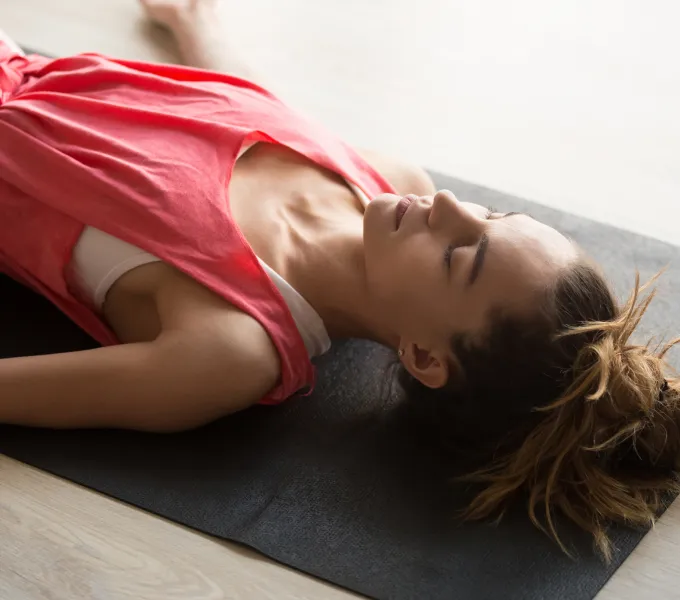
Do Your Rest: 5 Grounding Techniques to Try Now
Do you ever wake from a full night’s sleep, exhausted, fantasizing about what it would be like to cancel your entire day? Does the constant pressure to “do more” and “be better” at everything drain every ounce of your energy? Before you call it quits and sleep for a week straight, consider this: While sleep is undeniably important for your overall health and well-being, you may actually want to focus on physical and psychological restoration, aka rest.
Although they seem similar, rest is distinctly different from sleep. While sleep is a complex biological process in which your brain cycles through various wave patterns in an unconscious state, each working to support certain aspects of your health, the focus of rest is on taking moments to relax, refresh, and recover your mind and body from the daily impacts of stress — it’s less about zonking out, and more about dropping in.
Yes, binge-watching season 3 of Netflix’s Emily in Paris can be a form of rest (no judgment), grounding exercises are much more effective at encouraging rest and resilience throughout your entire nervous system.
Keep reading to find out why grounding is more than just a trendy buzzword, and learn 5 easy grounding exercises you can incorporate into your routine immediately.
What is Grounding and Why is it Worth Doing?
Grounding refers to certain activities that are designed to calm your nervous system. In general, grounding exercises can soothe your sympathetic nervous system (the part of your nervous system that is responsible for the “fight or flight” response that can help us out of danger) by strengthening your parasympathetic nervous system response (the part of your nervous system which helps your body to “rest and digest”). Essentially, grounding exercises may help your body become more resilient to the effects of stress.
Earthing is a type of grounding activity that refers to the physical act of touching your body to the earth. This may look like laying on the grass, walking in the sand, or putting your hands in water. It may seem a little woo-woo, but there are actual physiological health benefits to grounding when your body exchanges energy with the earth. Research shows that earthing can positively influence the electrical activity in your brain and muscles, while also supporting blood pressure, hormones, and your immune system.
Somatic grounding exercises are often used as part of Somatic Psychotherapy which can be helpful for those who are healing from PTSD or other types of trauma. In moments of anxiety or stress, somatic grounding activities use your senses (sound, sight, taste, touch, and smell) to help you shift your focus from your stressors, and allow your nervous system to rest.
5 Easy Grounding Techniques to Try
Alternate Nostril Breathing
Not only is the act of slow breathing soothing to your nervous system, but you’ll need to focus on the coordination of your fingers to nail this breath. Practice for several rounds of breaths, and give your nervous system a well-deserved distraction.
How to practice alternate nostril breathing:
Sit in a comfortable position and take a few slow breaths into your belly to prepare. When you're ready to start, place your right index and middle finger on the space between your two eyebrows with light to firm pressure and repeat the following steps:
- Use the tip of your right thumb to close your right nostril as you inhale through your left nostril.
- Lift your thumb and use the tip of your ring finger to close your left nostril as you exhale through your right nostril.
- Inhale through your right nostril.
- Use the tip of your right thumb to close your right nostril again, and exhale through your left nostril.
This is one round of alternate nostril breathing. Repeat for several repetitions or minutes. If you can, head outside and practice while sitting outside in the grass for the added benefit of earthing.
An Aromatic Self-Massage
Grab a clementine, small lemon, or lime and give it a sniff — the fresh citrus smell will help wake you up. Then roll the fruit back and forth over your forearm to help melt away the tension that builds up in these muscles as you work. This may quickly become your favorite grounding exercise.
Viparita Karani (Legs up the Wall Stretch)
Yoga inversion poses are not only more invigorating than a shot of espresso, Legs up the Wall Stretch can improve circulation, while helping you relax and de-stress.
How to practice legs up the wall:
- Start by sitting sideways, upright against a wall.
- Rotate to stretch your legs up to the wall while pivoting to rest your whole upper body on the floor.
- Gently tighten the front of your legs to keep your legs stretched towards the ceiling.
- Allow your arms to rest out in a “T” from your sides.
- Hold this pose for several breaths and soak up the restorative energy before slowly pivoting back into a seated position.
Close your eyes to block out any visual reminders of what is causing your stress response, and focus on feeling your body sink heavily into the ground.
Painting Your Fingernails
Yes, really. The precise act of painting your nails will not only help you focus on keeping the color away from your cuticles —and off of that work email you accidentally “replied all” to — this sneaky way to ground incorporates a tiny moment of self-care. Open a window to vent out those fumes and keep your air fresh.
Shake it out
This includes any kind of movement that is pain-free and feels good to your body. In more intense moments of trauma and stress, it is not uncommon for your body to freeze and hold the stress. Often a quick walk outside, jumping jacks at your desk, or even just shaking out your limbs (or entire body), can help you move away from the stress that is impacting you.




